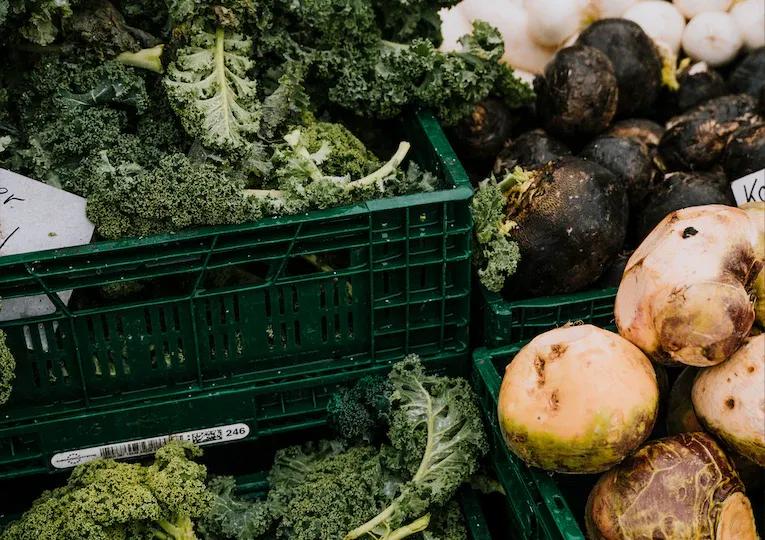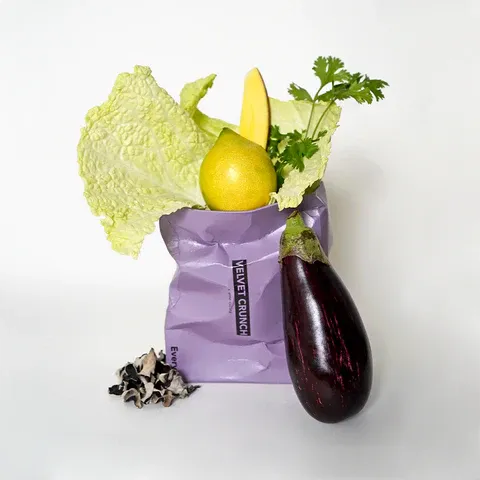Food Waste – When Edible Food Lands in the Trash.
We live in a world of excess and over consumption. We buy more than we can consume and the result? A shameful amount of wasted food. We’ve explained below how you can reduce your personal food waste.

Food Waste – Counteracting overconsumption.
Did you know that Germany produces 12 million tons of food waste per year? The main contributor to this staggering number is primarily private households, which make up roughly 52% or 6,1 million tonnes. This can be broken down to 75kg per person, per year with a steady annual increase. The size of this number needs to sink in for a second, because it's huge! However, once we’ve processed this, we must act immediately. We’ve outlined how you can keep your personal food waste to a minimum, and also help others to do the same!
Contents of this article:
- Food waste - what does it mean exactly?
- Quick explanations: Food waste, food loss, expiration dates etc.
- Food waste: the facts and numbers
- Food waste and best-before dates
- How you can reduce your food waste
Food waste – what does it mean exactly?
Food waste refers to the food that can and should be eaten, but instead of landing on your plate, it goes directly into the trash. Why this occurs can be attributed to a variety of factors. If an apple looks more like a pear, or if a carrot has an atypical shape, it has a slim chance of being sold in a supermarket. Consumers value produce that looks ‘perfect’, and even if flavour and nutrients are unchanged, people are less likely to buy it.
In the restaurant and gastronomy industry, lots of food remains from plates also end up in the trash. Here, the topic of hygiene and sanitation also play a big role, but surely there is a better solution than just throwing it away?
As we’ve mentioned before, we can’t just point fingers at food producers and retail, because we (you and I) are also culprits when it comes to food waste. The apple you just took a bite of doesn’t taste as good as you’d hope? Out with it. The tomatoes you bought and forgot in the back of the fridge? Gone! And so on…the cycle never stops. However, the good thing is, that with the right information and tips, you can reduce your waste and contribute to a more food-secure future. We’ll tell you how.

Quick explanations: Food waste, food loss, expiration dates etc.
Have you ever googled ‘food waste’? If so, you’ve probably noticed that a variety of terms are used within this context. To avoid mistakes and also bring about better clarity, we’ve explained these in detail for you.
- Food Waste
Food waste refers to the food at the end of the value chain i.e. it has already reached the consumer, restaurant or supermarket and is disposed of there for a variety of reasons.
- Food Loss
This is the waste that is caused at the beginning of the value chain i.e. at harvest, during transport or storage of food. For example, extreme weather conditions can cause poor quality harvest or alter the product specifications or quality standards, and therefore render the food item as unusable.
- Residual Food Waste
This refers to food that is wasted at any point in the supply chain, regardless of why or how.
Food Waste – The facts and numbers
Food waste is caused in all areas and along the entire supply chain. From production and cultivation of raw ingredients, to retail and gastronomy, all the way to private households. The following diagram shows the annual percentages of food waste in the respective categories.
- Roughly 30% (or 3,6 million tonnes) of food is already thrown out at the beginning of the supply chain. During production and processing of foods, many items are disposed of that don’t correspond to the right ‘aesthetics’, were stored incorrectly or have other defects due to transport.
- Wholesale and retail have a contribution of only 4%, which is still a staggering 0,5 million tonnes. This industry has the smallest contribution to the global food waste issue. However, this is also due to the fact that they have already undergone a rigorous check and only source the perfect food with the desired appearance.
- As already mentioned, private households are the biggest culprits at 52%. 6,1 million tonnes of perfectly usable food are thrown out for no better reason than forgetfulness or ignorance.
- The percentage of out-of-home catering - i.e. gastronomy, restaurants, events and catering as well as company and community catering - is 14% (1.7 million tonnes).

Another interesting aspect are the demographic discrepancies. Studies have indicated that food waste is much higher in certain age groups than in others. Older generations that grew up during the second world war have the tendency to throw away much less food. Younger generations unfortunately are more inclined to throw away perfectly good food. And now that fact that no one anticipated: Generations X and Y are the biggest food-waste causers! The best-before or expiration date plays a major role here: most young people would label a food product as ‘spoiled’ shortly after it has passed the best-before date. These same products would still be considered edible and ‘shelf-able’ by older generations.

How does all of this look on an international scale? Unfortunately, just as bleak. In developing countries, about 40% of food is wasted. The reason is attributed to insufficient infrastructure and technologies, poor storage and cooling facilities as well as extreme and unpredictable weather conditions. In industrial countries like Europe and North America the annual per capita amount of food waste is about 95-115kg. In Germany it’s about 75kg per capita. Switzerland and Belgium are at a whopping 310kg and 345kg per capita respectively. The USA sweeps them all, at a shocking 126 million tonnes of wasted food per year, calculated to 415kg per head.
Food Waste and best-before dates
Your yoghurt has passed the best before day, yet again? Then you’re surely asking yourself the question: do I throw it out or is it still ok to eat? Answer: open, inspect, smell, and test. The best-before date is designed to give the consumer an estimate of how long the food item is good for. Should your yoghurt, tofu etc. have surpassed this date, chances are it's still perfectly good to eat. Did you know, that the food industry is even contemplating getting rid of ‘best-before’ dates to help counteract this enormous waste problem?
Frozen food manufacturers also have a best-before date. However, if you store these properly and ensure that the cooling chain remains uninterrupted, the food item is usually ‘good’ for much longer than the date indicates. Food waste is an essential part of Every.’s philosophy, and a topic that we have devoted a lot of time to. Shopping frozen food is an excellent way to reduce food waste, as these best-before dates are months, if not years ahead of you. Our delicious products are conveniently stored in a freezer and offer an uncomplicated and nutritious meal solution. Browse our entire collection here.
How you can reduce your food waste?
1. Foodsharing is Caring.
Food sharing is based on the idea that food that is still edible but not buy-able is prioritised. This includes foods that were produced in excess, that don’t fit the aesthetic criteria or have passed the best-before date. Producers, suppliers etc. can drop off these ‘unacceptable’ products at various food sharing organisations. These are the passed on to aid organisations or individuals. In some cases this involves a small fee, but often they are also free.
Have you over-shopped once again and don’t know what to do with your extra food? Maybe ask your friends if they have any use for your food before you throw it out. Otherwise, there are plenty of facebook groups or others organisations to which you can donate your food and keep it from being wasted unnecessarily.
2. Frozen food
The immense advantage of frozen food, is that you don't have to be worried about imminent expiration dates or spoilage. Frozen food keeps for months if not years. This is the case for Every. products as well. The food stays fresh, crisp and full of nutrients. Discover our entire range of frozen, vegan ready-made meals.

The following Every. products will expire by the end of January 2023. In order to avoid any unnecessary food waste, we're offering you a special discount of -30%. These products will not be returning to our assortment, so this is your last chance to get them!
1. Wild Mango
2. Carrot Cake
3. Acai Bloom
7. Happy Quinoa
8. Umami Flip
3. Shop the right quantities.
You often select XXL or bulk portions that you don’t end up using? This is often due to the fact that large quantities are designed for families and often come with an attractive price tag. Instead of buying your produce in bulk, opt for individual quantities that you know you’ll use soon. Even better, is to focus on regional and seasonal produce and purchase these at farmers markets.
4. Focus on the inner value, not the outward appearance.
This is true also for fruit and vegetables. Curved cucumbers, carrots with a side growth or a funny-looking eggplant. This is nothing more than nature doing something slightly different, but in no way affects flavour, nutrient profile or overall quality. Supermarkets don’t like these irregularities and therefore don’t sell them. Nowadays, there are lots of online shops and delivery services that sell ‘ugly’ produce that’s just as tasty, and often cheaper too!
5. Weekly planning and shopping lists.
Once you've arrived at a supermarket, the options at your disposal can often be overwhelming. Its easy to quickly forget why you came in the first place and cause you to buy foods you didn’t need. This is a classic cause of food waste. Its much easier to start with a weekly plan of your meals and to write a corresponding shopping list. This will not only ease your shopping and cooking experience, but will also prevent you from impulse buying foods you don’t need, that you are likely to then throw out.
6. Fridge or pantry?
Did you know that for most food-groups, there’s an ideal and even designated fridge-space? With the right storage, especially for fresh and sensitive foods, you can make sure that foods are kept fresh for longer. This is how you do it:
The top shelf is usually the ‘warmest’ at 7-10°C. Here you should store foods that don’t expire quickly. Such as: prepared meals, jams or sauces.The middle shelf is a bit colder at 6-7°c. This is ideal for dairy products such as milk, yoghurt and cheese. The lowest and coldest shelf is where you should store the foods that go off the fastest. This includes things like fish, meat and hams. Last but not least, fruit and vegetables belong in the produce compartment (often drawers in a fridge). Here there are some exceptions: bananas, legumes, cucumbers and tomatoes should be stored in a pantry rather than a fridge. How to best maintain your fridge and freezer is discussed in detail in our article about defrosting your freezer.
And what belongs in the pantry? Dry foods. Rice, pasta, nuts, conserved products and other foods that have a long shelf life (e.g. coffee, cereal, potatoes). This is of course also all dependent on what kind of a pantry you have. Are the contents constantly exposed to sun? Or is it a fairly cool and dark area? This is big factor to take into account when storing your groceries.
7. Think before you toss!
What to do with a dry apple or brown bananas? There are so many options! Dull apples or pears are a great addition to a smoothie or can also be transformed into a puree or jam. Overly ripe bananas are a key ingredient for a juicy banana bread. If you freeze them, they're also a delicious and healthy ice cream alternative. Vegetables that aren’t super fresh anymore, can also be repurposed to make a delicious smoothie.
If you’ve made too many potatoes, pasta or rice the day before, don't worry! These foods keep for a few more days and can also be repurposed into a totally new delicious meal. Make a curry or stir-fry, add them to a salad or make into a soup. Leftover dips and sauces can also be turned into a great flavour add on to a salad dressing or stir fry.

8. Use the apps
You want to help make the world more sustainable? You want to use your resources effectively and also help counteract food waste? A few years ago one might have filtered through waste containers outside of supermarkets. Nowadays, this is much easier and maybe a bit less messy. There are countless apps available that show you where you can procure leftover food from supermarkets, caterers or restaurants. These can often be picked up before the store closes in exchange for a small price tag. Here are some apps that could be useful: Etepetete, Zu gut für die Tonne!, Too Good to Go, Eat Smarter and many more.
In conclusion, the topic of food waste will sadly accompany us for many more years to come. But each individual can help and do their part to keep personal food waste to an absolute minimum. Correction: each individual must do their part to reduce food waste. According to the World Hunger Organisation, approximately 811 million people are undernourished while a staggering 2 billion people are malnourished. This begs the question, in light of how much food gets wasted, how can this be?
Discover more articles from the Every. Magazine:
- Earth Day – A Day For Our Planet
- Vegan Eating – Everything You Need to Know
- Quick and Healthy Lunch? Easy as Pie.
- Meal Prep – Cook Once, Enjoy Often!
- Intuitive Eating – The Science of Listening to Your Body
For even more foodie-content follow us on Instagram and join the Facebook Community to get involved in meal creations and to stay up to date on all things Every.